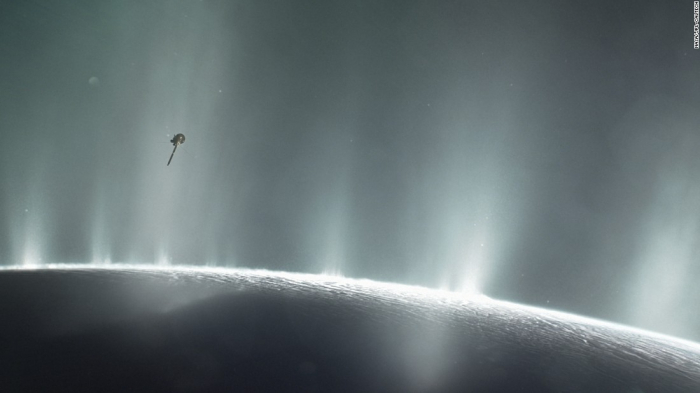In 2017, astronomers announced that ocean worlds such as Europa and Enceladus may be the best chance for finding life outside of Earth in our solar system. This discovery, along with a previous detection of complex organic molecules in the plumes last year, further suggests that the moon could support life as we know it.
Before NASA's Cassini mission studied Saturn and its moons for 13 years, beginning in 2004, Enceladus held many secrets. Cassini revealed that there was a global ocean between the moon's icy crust and its rocky core.
Although the Cassini mission ended in a blaze of glory when it disintegrated in Saturn's atmosphere, surprises from the data it collected will be released for years to come.
A study detailing the latest discovery from Cassini data was published Wednesday in the Monthly Notices of the Royal Astronomical Society.
"If the conditions are right, these molecules coming from the deep ocean of Enceladus could be on the same reaction pathway as we see here on Earth. We don't yet know if amino acids are needed for life beyond Earth, but finding the molecules that form amino acids is an important piece of the puzzle," said Nozair Khawaja, who led the research team of the Free University of Berlin.
Amino acids are the building blocks of life. Organic compounds are the byproduct of the reactions that create amino acids. In Earth's oceans, vents on the ocean floor create these reactions. The researchers think this same process could be unfolding on Enceldaus.
"This work shows that Enceladus' ocean has reactive building blocks in abundance, and it's another green light in the investigation of the habitability of Enceladus," said Frank Postberg, study co-author and head of planetary science and remote sensing at Free University of Berlin's Institute of Geological Sciences.
Cassini's Cosmic Dust Analyzer and the Ion and Neutral Mass Spectrometer sampled and measured the ice grains and vapor being ejected by cryo-volcanic plumes from warm cracks in the ice crust. They also sampled Saturn's E ring, which was formed by ice grains that escaped Enceladus' gravity.
In 2015, when Cassini flew the closest it ever came to Enceladus, molecular hydrogen was detected in the plume. Scientists believe the molecular hydrogen forms as a result of the interaction between water and rocks when it's in a hydrothermal environment.
When looking at the potential habitability of an environment, NASA's checklist includes water, organics and a food or energy source toward the top.
Measurements of methane, molecular hydrogen and carbon dioxide in the global ocean show that the ocean has the chemical energy necessary for microbes to produce methane -- if there are microbes. Recent studies show that there are microbes like this in our own ocean.
The 2018 study added the detection of large, carbon-rich organic molecules to the previous findings, surprising the researchers. They believe that the molecules are caused by chemical reactions between Enceladus' rocky core and the ocean's warm water.
Based on their data, these molecules could be sitting in a thin film on top of the ocean, where bubbles can rise and burst.
"They may represent life's chemical building blocks or even the remains of past microbial populations or there may be simple abiotic ways to explain the origin of the materials," said Hunter Waite, principal investigator for the mass spectrometer.
"In any event, specific identification of these organic compounds is the next step in our search for life in Enceladus' ocean. The complexity of the organic compounds identified was beyond our wildest expectations -- non-soluble complex organics floating as a film on an alien ocean. Wrap your head around that."
Proposals for missions to further study Enceladus were previously submitted to NASA. Waite suggests that the next step would be a new mission to fly through the E ring and the plumes of Enceladus to provide data.
CNN
















































